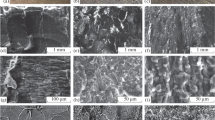Abstract
The influence of the overmoulding processing conditions (melt and mould temperatures, holding pressure and injection rate) on the adhesion strength between two polymers in a hard–soft part was studied. The used materials were thermoplastic vulcanized elastomer (TPV) and polypropylene (PP). The study of the adhesion strength was made by measuring the essential work of interfacial fracture (EWIF) concept using a single edge-notched tension (SENT) geometry. It was observed that, the data distribution was good since an adequate correlation between the total work of interfacial fracture and the ligament length was obtained. It was verified that, when the melt temperature, and in some cases, the mould temperature are increased, a higher adhesion strength is obtained. These parameters affect in higher degree the adhesion strength, since they may improve the interdiffusion and the wetting process of the PP substrate by the molten material (TPV), causing as a result a good contact between them. A little influence was observed in the case of the holding pressure and injection rate.










Similar content being viewed by others
References
Rees H (1994) Understanding injection molding technology. Hanser Publishers, Munich
Hudacek L (2004) How to optimize adhesion in hard-soft overmolding. Plastics Technology Online, New York. https://doi.org/www.ptonline.com/articles/200402fa2.html. Accessed 14 Jan 2008
Holden G, Kricheldorf H, Quirk R (2004) Thermoplastic elastomers. Hanser Publishers, Germany
Martín-Martínez JM (1998) Adhesión y uniones adhesivas. CYTED/Universidad de Alicante, Alicante
Young RJ, Lovell PA (1991) Introduction to Polymers, 2nd edn. CRC Press, Boca Raton
Wu S (1982) Polymer interphase and adhesion. Marcel Dekker Inc., New York
Weng D, Andriues J, Morin P, Saunders K, Politis J (2000) J Inj Molding Technol 4:22
Clutton EQ (2001). In: Moore DR, Pavan A, Williams JG (eds) Fracture mechanics testing methods for polymers, adhesives and composites, ESIS Publication 28. Elsevier Science, Amsterdam
Candal MV, Terife G, Gordillo A, Santana OO, Sánchez JJ (2008) Comparison of methods for the study of the adhesion strength between two overmoulded materials, Polym Test (submitted)
Lauke B, Shüller T (2001) Int J Adhes Adhes 21:55. doi:https://doi.org/10.1016/S0143-7496(00)00028-2
Orwoll RA, Arnold PA (1996) In: Mark JE (ed) Physical properties of polymers handbook—AIP Series in polymers and complex materials. American Institute of Physics Press, New York
C-Mold (1998) Getting started with C-Mold. Advanced CAE Technology Inc., New York. https://doi.org/www.dc.engr.scu.edu/cmdoc/GS_doc/GSTOC.doc.html. Accessed 14 Jan 2008
Candal MV, Gordillo A, Terife G, Santana OO (2007). In: Proceedings of the 65th Annual Technical Conference, ANTEC 2007. Society of Plastics Engineers SPE, Cincinatti, p 620
Karger-Kcosis J, Czigány T, Moskala EJ (2000) J Mater Sci Lett 19:1610
Karger-Kcosis J, Barany T (2002) Polym Eng Sci 42:1410
Haughie DW, Buckley CP, Wu J (2006) Biomaterials 27:3875. doi:https://doi.org/10.1016/j.biomaterials.2006.03.010
KimS, Suh N (1986) Polym Eng Sci 26:120
McKelvey JM, Strome TH (1959) Plast Eng June:107
Huang D, Chen R (1999) Polym Eng Sci 39:2159
Bhat S, Extrand C (2005) In: Proceedings of the 63th Annual Technical Conference, ANTEC 2005. Society of Plastics Engineers SPE, Boston, p 1862
Acknowledgements
Candal wishes to thank “Dirección de Desarrollo Profesoral” of the universidad simón bolívar (USB) and the fondo nacional de ciencia, tecnología e investigación (FONACIT) from Venezuela for the financial support for the trips to Barcelona, Spain, to work on her Ph.D. thesis at the universitat politècnica de catalunya (UPC). She specially would like to thank institutional relations of the Usb and UPC for exoneration of payment of her Ph.D. Authors would like to thank the “Decanato de Investigación y Desarrollo” from Universidad Simón Bolívar for generous funding through grant DID-GID-02. Also they thank the centre catala del plastic and the laboratory “e” (USB) for allowing them to use their facilities and equipments that made possible the development of this investigation.
Author information
Authors and Affiliations
Corresponding author
Rights and permissions
About this article
Cite this article
Candal, M.V., Gordillo, A., Santana, O.O. et al. Study of the adhesion strength on overmoulded plastic materials using the essential work of interfacial fracture (EWIF) concept. J Mater Sci 43, 5052–5060 (2008). https://doi.org/10.1007/s10853-008-2667-1
Received:
Accepted:
Published:
Issue Date:
DOI: https://doi.org/10.1007/s10853-008-2667-1




